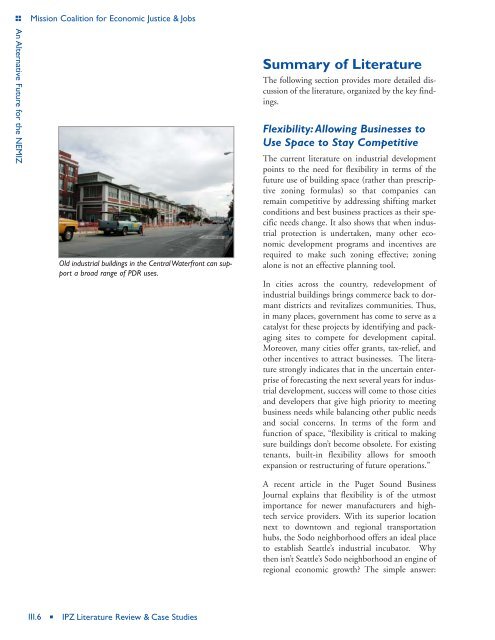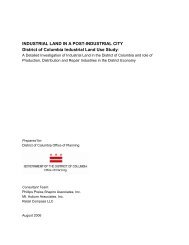An Alternative Future for the North East Mission Industrial Zone
An Alternative Future for the North East Mission Industrial Zone
An Alternative Future for the North East Mission Industrial Zone
Create successful ePaper yourself
Turn your PDF publications into a flip-book with our unique Google optimized e-Paper software.
<strong>An</strong> <strong>Alternative</strong> <strong>Future</strong> <strong>for</strong> <strong>the</strong> NEMIZ<br />
<strong>Mission</strong> Coalition <strong>for</strong> Economic Justice & Jobs<br />
Old industrial buildings in <strong>the</strong> Central Waterfront can support<br />
a broad range of PDR uses.<br />
III.6 IPZ Literature Review & Case Studies<br />
Summary of Literature<br />
The following section provides more detailed discussion<br />
of <strong>the</strong> literature, organized by <strong>the</strong> key findings.<br />
Flexibility: Allowing Businesses to<br />
Use Space to Stay Competitive<br />
The current literature on industrial development<br />
points to <strong>the</strong> need <strong>for</strong> flexibility in terms of <strong>the</strong><br />
future use of building space (ra<strong>the</strong>r than prescriptive<br />
zoning <strong>for</strong>mulas) so that companies can<br />
remain competitive by addressing shifting market<br />
conditions and best business practices as <strong>the</strong>ir specific<br />
needs change. It also shows that when industrial<br />
protection is undertaken, many o<strong>the</strong>r economic<br />
development programs and incentives are<br />
required to make such zoning effective; zoning<br />
alone is not an effective planning tool.<br />
In cities across <strong>the</strong> country, redevelopment of<br />
industrial buildings brings commerce back to dormant<br />
districts and revitalizes communities. Thus,<br />
in many places, government has come to serve as a<br />
catalyst <strong>for</strong> <strong>the</strong>se projects by identifying and packaging<br />
sites to compete <strong>for</strong> development capital.<br />
Moreover, many cities offer grants, tax-relief, and<br />
o<strong>the</strong>r incentives to attract businesses. The literature<br />
strongly indicates that in <strong>the</strong> uncertain enterprise<br />
of <strong>for</strong>ecasting <strong>the</strong> next several years <strong>for</strong> industrial<br />
development, success will come to those cities<br />
and developers that give high priority to meeting<br />
business needs while balancing o<strong>the</strong>r public needs<br />
and social concerns. In terms of <strong>the</strong> <strong>for</strong>m and<br />
function of space, “flexibility is critical to making<br />
sure buildings don’t become obsolete. For existing<br />
tenants, built-in flexibility allows <strong>for</strong> smooth<br />
expansion or restructuring of future operations.”<br />
A recent article in <strong>the</strong> Puget Sound Business<br />
Journal explains that flexibility is of <strong>the</strong> utmost<br />
importance <strong>for</strong> newer manufacturers and hightech<br />
service providers. With its superior location<br />
next to downtown and regional transportation<br />
hubs, <strong>the</strong> Sodo neighborhood offers an ideal place<br />
to establish Seattle’s industrial incubator. Why<br />
<strong>the</strong>n isn’t Seattle’s Sodo neighborhood an engine of<br />
regional economic growth? The simple answer:












